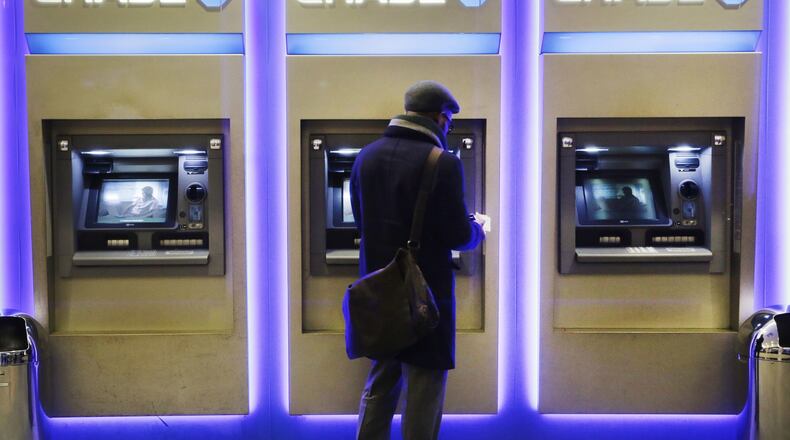Remember when cash was king?
When cash really ruled, ATMs seemed like one of the world’s great inventions for letting consumers be consumers.
Now, banks and other financial companies are looking for new ways to make the machines do our bidding beyond cash withdrawals and checking balances.
But a bunch of Americans, me included, don't use ATMs much any more. A couple pups just out of college told me it had been at least a year since they last sidled up to one. Cash isn't dead, but there's ample evidence it's fading.
VIDEO: Tammy the Timeless Teller jingle
This summer is the 50th anniversary of the automated teller machine. Labeled early on as a “robot cashier,” it was an early step in the empowerment of consumers — and in the ability of businesses to get customers to shoulder some of the workload.
Both themes now help drive a lot of our digital economy in ways that far surpass the vision of the ATM.
Early versions of the machine must have been maddeningly clunky. One unveiled at Barclays Bank in England in 1967 required customers to get a one-time voucher from human tellers. The voucher could then be used later to get cash at the ATM. Only bank customers with the best credit were afforded such access.
Eventually, though, ATMs allowed customers to break free from the long lines and limited hours at banks. All of a sudden, people could get their own money any time they wanted. Genius!
They made it more possible to make impromptu purchases, said Bernardo Batiz-Lazo, who has written extensively on the history of ATMs. (He's a business history and bank management professor at Bangor University in Wales.)
People no longer had to budget carefully for the weekend. Run out of cash halfway through a wild Saturday night? Just get another fill up.
“The cash machines were the beginning of self-service banking that evolves today into the demand to bank anywhere, anytime,” Batiz-Lazo said.
Of course, there was a payoff for banks and other businesses.
Moving lines
ATMs gave banks another way to serve customers without adding to lines in bank lobbies. (Though it sometimes created new lines at ATMs.) The machines could pick up some of the slack when cost-cutting banks reduced staff or closed branches, according to the professor.
They also acted as billboards. And banks that added lots of ATMs found a new avenue to attract customers, especially if they tried to give the machines a little personality.
Long-time Atlantans can remember First Atlanta Bank’s Tillie the Teller marketing jingle: “I’m Tillie the All-Time Teller. I work for First National Bank.” (I can’t tell you how many times I’ve heard my wife and her sisters sing that little ditty.)
Eventually other businesses got in on the good times. Independent operators placed ATMs in bars, clubs, convenience stores and the like. Ready access to cash meant customers were likely to spend more. And then there were those ATM fees, the bane of consumers who despised the idea that they would be charged money to get convenient access to their money.
There have been other bumps, including robberies at ATMs or just the fear that someone would see our PIN number or skim our information. Heck, bad guys would drag off an entire ATM to get at its insides.
Now, the ATM business faces another challenge.
The number of ATMs in the United States has barely grown since 2009, according to Retail Banking Research. It forecasts only teeny growth through at least 2021. And the number of withdrawals from ATMs tied to financial institutions had dipped, even as the total amount of cash withdrawn has grown, according to the Federal Reserve.
Surveys continue to show Americans gradually making fewer purchases with cash as more businesses make it easier to use plastic and mobile devices.
Mobile rivals
A move away from cash isn’t the only issue. Internet and mobile banking are taking a growing share of business. The percentage of customers who use ATMs as their primary method of managing bank accounts has dropped to 6 percent, down from 17 percent in 2009, according to surveys by the American Bankers Association.
I’m sure much of this is not great news for a company like NCR, a Fortune 500 company based in Duluth that is heavily invested in ATMs. The company makes the machines in a number of spots around the world, including in Columbus.
But the company and other ATM makers and their customers are pushing for new ways to grow the business.
“Get ready to be seeing more of your local ATM, because you are going to have a lot more reason to be there,” said David Tente, an executive with the ATM Industry Association.
Banks have trotted out plans for ATMs to go cardless, instead accepting connections through mobile devices, a feature that should grow significantly next year, Tente told me.
You may see more ATMs with touchscreens, bitcoin options, video connections to bank workers and features that allow customers to choose multiple denominations for their cash, he said. Expect also to be able to make person-to-person money transfers.
Of course, some of the things he mentioned you can already do some version of with a smartphone.
Did I mention that this year doesn’t just mark a big anniversary for the ATM? It’s also the 1oth birthday of the iPhone.
Find Matt on Facebook (https://www.facebook.com/mattkempnercolumnist) and Twitter (@MattKempner) or email him at mkempner@ajc.com.
MYAJC.COM: REAL JOURNALISM. REAL LOCAL IMPACT.
AJC Unofficial Business columnist Matt Kempner offers you a unique look at the business scene in metro Atlanta and beyond. You'll find more on myAJC.com, including these columns:
Never miss a minute of what's happening in local business news. Subscribe to myAJC.com.
About the Author
Keep Reading
The Latest
Featured





